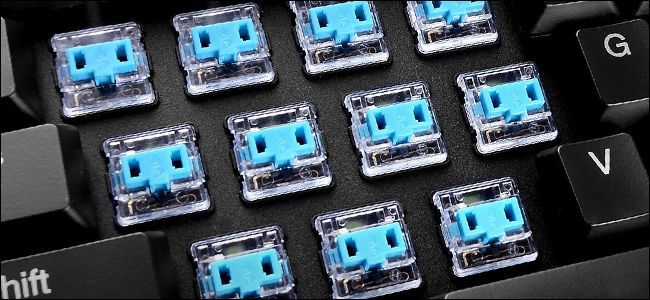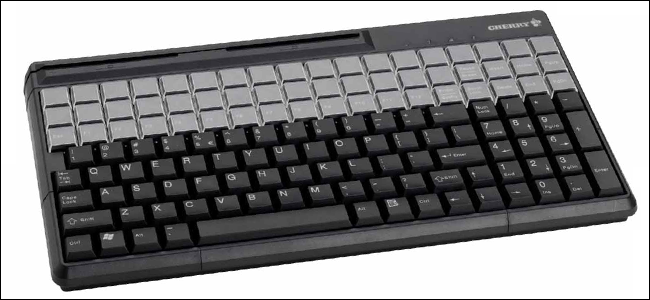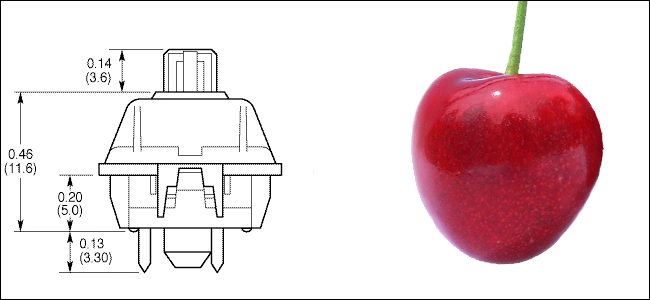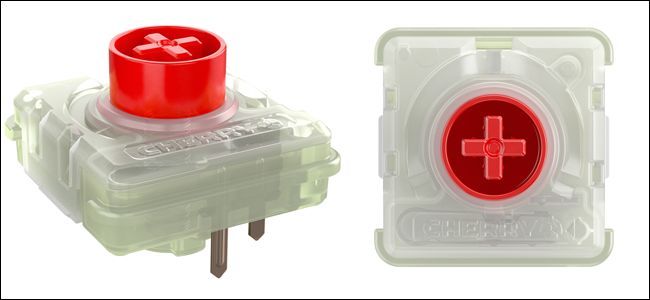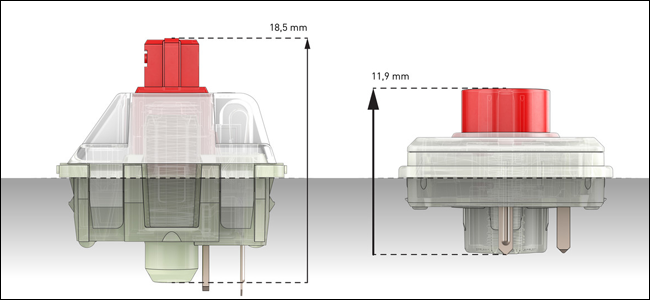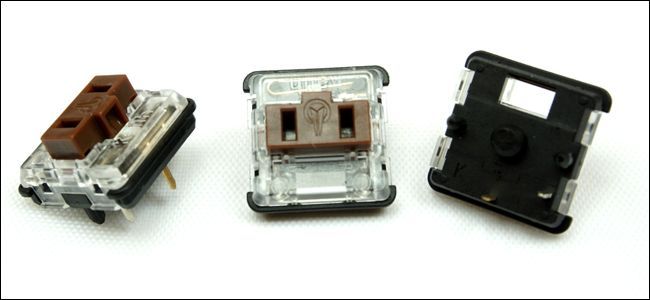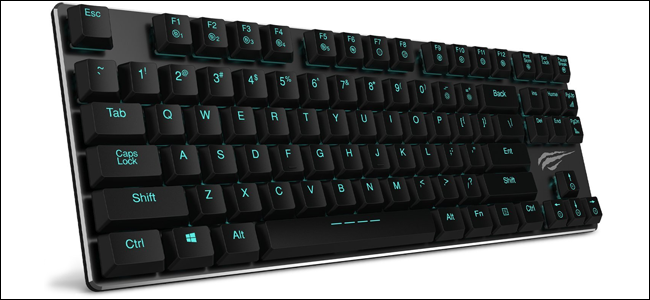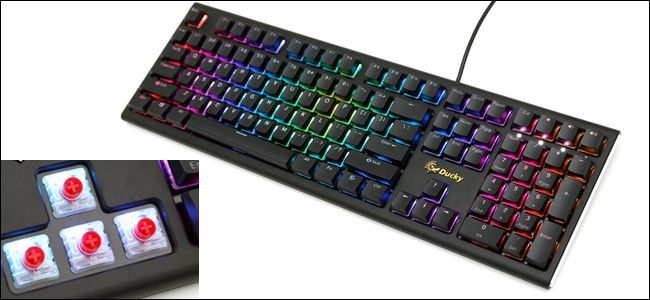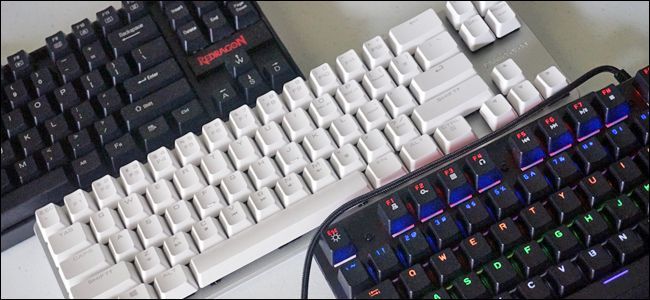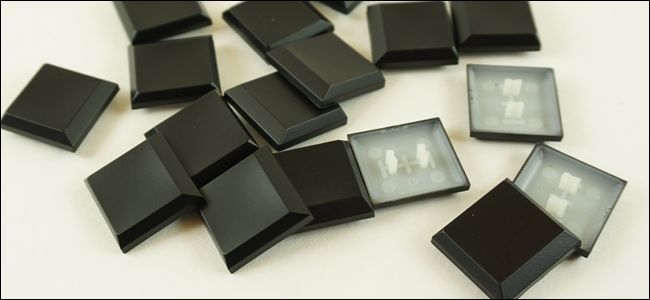Quick Links
Mechanical keyboards are neat! But no one would say they're sleek or compact. Even the smallest mainstream models, the "60%" boards, are about the size and weight of a paperback book. But that might be changing very soon.
Cherry, the German company famous for creating the original MX switch design that started the modern mechanical revival, revealed a new low profile switch at CES 2018. Combined with an existing and growing offering from Chinese competitor Kailh, we're about to see an explosion of sleek, streamlined keyboards that preserve the tactile feel and customization options that mechanical fans crave.
Why Are Mechanical Keyboards So Big, Anyway?
To understand the significance of new low profile designs, we have to look at why mechanical keyboards tend to be so much bigger than conventional rubber dome and scissor-switch designs. First, the modern Cherry MX switch isn't modern at all, at least in terms of its overall design. German keyboard supplier Cherry first patented the original MX design way back in 1984. At the time, nothing about computers was small or sleek, so it really didn't matter if your enormous keyboard couldn't fit into a breadbox.
Cherry's MX switch design proved so popular and so resilient that the company began supplying the switches for other keyboard makers, including industrial and business-to-business manufacturers. You can find MX switch variants on thirty years' worth of electronics, in everything from consumer-grade keyboards to retail point of sale kiosks to medical scanning equipment. And when it comes to the business-to-business stuff, none of it needs to look particularly good or fit into a backpack. Cherry did make some low profile switch variations, the ML series from the 1990s, but they never caught on with either Cherry's corporate customers or keyboard enthusiasts.
When mechanical keyboards came back into style in the late 2000s, keyboards with Cherry MX switches were once again popular with consumers, particularly gamers and dedicated typists. (Don't call it a comeback.) By that point, the original Cherry MX design patent had expired, allowing a growing number of companies to copy it and expand on it with more variations and cheaper "clone" switches. And now you can buy a Cherry-style mechanical keyboard for under forty bucks.
But make no mistake: despite the smaller cases, fancy switch variations, and near-infinite selections of key layouts and keycaps, most of the modern mechanical keyboards on store shelves are using 30-year-old technology for typing.
Newer, Smaller Switch Designs Are Finally Here
In response to keyboard makers' wishes to compete with the slim, sleek designs seen on products like Apple's Bluetooth keyboards, Cherry has developed the new Cherry MX Low Profile Switch. This new design shrinks the overall switch dimensions from 18.6mm tall (from the bottom of the plastic housing to the tip of the cross-shaped stem) to just 11.9mm.
This is a lot more impressive than it sounds. One of the key aspects of mechanical keyboards is a long key travel, the distance between the key's resting position and its fully depressed position. Longer key travel is generally preferred by gamers and typists, and MX switches offer 2-4mm for either activation or full depression. For comparison, laptop keyboards tend to offer less than 1.5mm of key travel. The new MX Low Profile switch preserves an impressive 3.2mm of maximum key travel (the activation point might be less, depending on the switch variation).
The MX Low Profile switch also preserves some of the more advanced features from modern MX variant switches, including compatibility with compact RGB LEDs offering nigh-infinite color combinations, and a stem that should be compatible with contemporary keycaps designed for MX keys. Some keycap profiles may be too tall to be fully depressed on a new low profile switch---Cherry hasn't said much about this---but the new circular-reinforced stem and cross center should mean new keycaps can be designed for the low profile switches with minimal cost to suppliers.
Cherry isn't the only game in town when it comes to new, skinnier switch designs, either. Kailh, a Chinese firm that's been manufacturing MX-compatible switches for years, released a new and wholly different low profile "Choc" switch last year. While it's designed for easy adaptation on modern PCBs and plate mountings, the Kailh low profile design is incompatible with both standard full-sized Cherry MX switches and the new MX Low Profile design. In fact, Kailh's switches bear a striking resemblance to the Cherry ML low profile design from the 1990s.
The Kailh switches with their rectangular stems are much smaller than the MX Low Profile switches, at only 5.9mm of total height. That smaller design comes with a compromise: the key travel has a total of 2.4mm with an activation at 1.2mm, making them closer to laptop-style keys than full-sized Cherry keys in terms of "feel."
At the moment, Cherry is only showing off its MX Low Profile switch in a linear red variation, with a 45-gram activation force. Kailh is making its low profile Choc switches in blue "clicky", brown "tactile," and red linear variations, all with a slightly stiffer 50-gram activation.
Which Keyboards Have the Low Profile Switches?
Not many, yet. Aside from purpose-built demonstration units at trade shows, there are only three keyboards on the market at the time of writing, all using the smaller Kailh switches: the HAVIT full-sized "Ultra Thin" mechanical keyboard, a similar tenkeyless variant, and a Bluetooth model from DareU with a modified 60% layout. There's also a Bluetooth variant of the tenkeyless model that's much harder to find. Based on the branding and case designs, it looks like all of these keyboards are coming from the same whitebox manufacturer.
In addition to demonstration models, Cherry showed off a new production design at CES from its corporate partner Vortex, makers of the popular Poker series of 60% keyboards. The new keyboard is a variation of its Race design, a compact layout that crams in a full Function row and arrow keys into an all-metal case with a new USB-C connector. Another manufacturer, Ducky, had a full-sized "Blade" board with USB-C and Bluetooth connections, plus full RGB lighting. Both of these keyboard designs, and at least a few more, should be available at retail sometime in the next few months.
There's another option for the more handy and adventurous user: building your own keyboard. Vendors are already selling the Kailh low profile keys individually, available for those advanced hobbyists who can assemble their own particle boards and wire and program keyboards themselves. At least one member of the popular Mechanical Keyboards subreddit has done so. Expect the Cherry MX Low Profile switches to be available for purchase soon, too.
What's Going to Change?
Probably less than you think, at least in the short term. One of the things that allowed mechanical keyboards to blossom into such a diverse segment was that the original Cherry MX switch design was out of patent protection, opening the doors for clones and refinements from a variety of suppliers. With a new switch design, Cherry will be able to exclusively manufacture the new low profile switches for twenty years in the US, and similar terms in most other countries. The same goes for Kailh's switches, and any new designs that pop up.
That means keyboard makers will have to buy directly from Cherry and Kailh for their low profile switches---an expensive proposition. Or they could go through the even more expensive process of designing their own low profile switch. So new keyboard designs with these exclusive switches will be expensive for the time being, especially for Germany-based Cherry, as the expense of buying components from a single supplier puts a floor on competitive pricing.
And even if a new wave of smaller, sleeker mechanical keyboards sweeps across the industry, don't expect these switches to show up in laptops any time soon. The 11.9mm housing of Cherry's Low Profile MX switch is already more than half the height of a typical modern laptop---makers wouldn't be able to fit those switches in with crucial components like the motherboard and battery without making their designs unfashionably thick. Even with Kailh's shorter switch design and chunkier "gaming" laptops, don't expect integrated mechanical keyboards on anything except the most expensive and niche models.
While these switches won't find their way into many laptops, expect them to pop up in Bluetooth-enabled designs right away. Wireless options for mechanical keyboards have always been a bit lacking---chock it up to a purist's enthusiasm for wires, I suppose. But initial batches of keyboards with both switches have included Bluetooth variants, probably because the smaller cases and shorter overall height will be ideal for throwing those boards in a backpack for use with a tablet or phone.
Assuming a mass adoption of one or both standards, there's also the keycap situation to think about. MX-stem keycaps may or may not be compatible with the new Cherry switches, but they certainly won't work for the Kailh switches, which use a double-prong connection instead of the cross-shaped stem. That's not a particularly big deal---caps for different stems aren't a new phenomenon, just ask Topre and ALPS fans---but it's something you should be aware of if you've amassed an expensive collection of keycaps so far.
Image credit: Amazon, Cherry Americas, Wikipedia, CherryMX.de, NovelKeys, Ducky Facebook, Dell

